
| 
| 
|
Please report any broken links or trouble you might come across to the Webmaster. Please take a moment to let us know so that we can correct any problems and make your visit as enjoyable and as informative as possible.
All images in this section are taken from the cruise book. Narrative has been transposed and added to the photos where appropriate.
"LIVERPOOL, ENGLAND, third largest of England's ports of call had as its main attraction a gigantic floating pier. It was large enough to accommodate both ourselves and our sister ship, the 'USS Wakefield', at the same time. Like an elevator, it rose and fell with the thirty foot change of tide, allowing ships moored alongside to set their lines taut, and not shift with the tide changes.
There is a story the British tell. If Liverpool does not have rain in the morning, she'll have it in the afternoon, anyway. The continual fog, rain, or dampness hovers over the city, adding deeper silence to the blackened ruins and the gutted churches. This was the ship's first closeup of buildings without roofs, and spaces without buildings. The air raid shelters and emergency water tanks were spotted in the rubble, oases which proved their worth. Four years of war were showing in the faces and clothing of the people. 'The lights came on' during one of the ship's stays in port.
Names such as Princess Street, Lime Street, and The Tatler Theater helped cloak the city with the 'All English' feeling. Double-decker trams and narrow gauge trains, tiny autos and 'funny' money were new experiences, soon to become as familiar as their American counterparts.
Liverpool might be well remembered as a depot for trips to Chester and Southport.

| 
| 
|
CHESTER had been an ancient camp of the Romans. Walls built by them still surround the Tudor style city and shelter it from the modern day world. From a tower atop this wall, Charles II saw the defeat of his armies on the plains of Chester. In one of the wall's towers, Turner, one of England's great artists had a studio.
The buildings were timber fronted stucco, of the Shakespeare era. The cathedral, however, was natural red sandstone, mellowed by the driving dampened wind. Interred with local aristocracy is the local publ-owner.
Chester fronts on the River Dee, marker of the division between England and Wales. Punts and motor craft furnished a busman's holiday to those so inclined to ride. The trip gave the travelers the opportunity of viewing Eaton Hall, seat of the Earl of Derby, promoter of the horse race bearing his name.
SOUTHPORT had been modified from her peacetime bathing resort career into a barbed wire barrier against the invader. Her hotels had been converted into hospitals and rest centers.
The pier of NAPLES, Italy, Molo Luigi Razza, more than any other single item lies a dying memorial to the deposed Fascisti. The false facade of marble and gilt fell with the crumbled rubble of the state. Bronze statues, typifying the spirit of the undying ancients, however, remained erect, haughtily surveying the remnants of the late regime. Dead, bloated ships which once protected the Italian lifeline clog the bay.
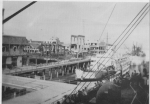
| 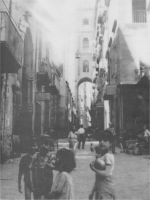
|
All Naples, however, is not in ruins. The Castle of St. Elmo, still intact dominates the city's highest hill. To this vantage point, Naples rises from the shore to display herself, garbed with one of the world's most beautiful locations. Buildings, some ancient, some modern, terrace the hill's side, falling away into the blue waters at the city's shore. Mount Vesuvius, with delicate pink clouds afloat overhead forms a distant backdrop.
Virgil, who was believed to be a sorcerer, once put the newly laid egg of a sea serpent into an iron cage. By magic, the egg was transformed into the Castel dell'Ovo (Castle of the Egg). The castle still stands; Virgil's tomb, also is in Naples.
The San Carlo Opera house, too, survived the onslaught to remain a gem in the dust of the city. With its area of 5157 square yards and stalls capable of seating 1000 spectators, it is one of Europe's largest, with its plush, and gilt, and emblazoned ceiling, it is one of the world's most elaborate. All Italy sings; the opera is the spirit of her singing.
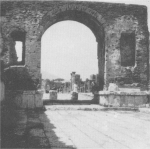
| 
| 
| 
|
Pompeii and here conqueror, Mount Vesuvius were but a truck-ride distant from Naples. Excavated from her bed of lava after 1800 years of silence, the ancient city's glories and perversions were bared in their artistry and baseness. Slowly emerging from the centuries' dust were the House of the Vetti, the theater, the forum, and the Temple of Jupiter.
The eruption of March, 1943, assisted the Allied bombers to find their targets in Naples. By one eruption, the volcano enslaved and silenced a people; by a second eruption, she freed another.
A landing craft, loaded to the gunwales with gold braid, left Naples for the Isle of Capri. The group, familiar with Radar, Loran, and radio direction finders, ignored the fog and proceed on their course. Such basic navigational observation as the sun's irregular appearance in alternate quarters of the sky worried some, but the coxswain held their confidence. He was following another craft across the mine field so he didn't need a compass. If the other craft had a compass he did not know. He did know, however, that the other coxswain had taken the route before and knew the way. Neither boat had a compass! All faces were red. But they blossomed a deeper scarlet when an Army tug rescued them from the mine field and led them to Capri. The lushness of the Blue Grotto and the relaxation of swimming in the Mediterranean relieved the nervous tension of the trip.
At Mondragona Beach the ship's party was greeted with a shaded welcome. 'If you set off a mine when in swimming, please realize that it was not left there intentionally'. The German command had expected this beach to be a point of invasion. Anzio, instead, had been used. This beach became a rest center for those who invaded elsewhere.
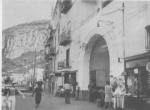
| 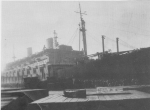
| 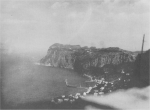
| 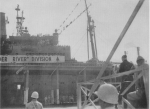
|
MARSEILLES was France reborn. The fountain of the Palais Longchamps played again. The Pink Elephant and Madame Clarey's did a thriving business. The women were stylish in whatever they wore, remodeled drapes, or cast-off suits. The 'French Look' had survived the war. Less than a month before the arrival of the 'Mount Vernon', the Rue de Canebiere had felt the marching of German boots. Now the street was a cosmopolitan parade. The foe left their submarine pens and scuttled ships as tokens of their departure, Also the rubble. Fear of the 'Mistral' prevented passage to the Chateau d'If, scene of Dumas' 'Count of Monte Cristo'. The best substitute, a view of the island castle and the harbor was obtained from the Cathedral of Notre Dame de la Garde.
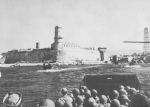
| 
| 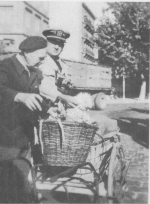
| 
| 
|
The very name ORAN whispered the mysteries which hovered behind the closed doors of the Casbah, of dancing girls and tinkling cymbals. Above the ageless native clay buildings rises a modern city whose skyscrapers silhouette themselves against the desert sunsets.
Oran, originally the largest French Naval Base had become the Allied Base of operations against Sicily. On none of the ship's three visits to the port, however, was any of the 'Mount Vernon's' travelers allowed ashore. The city remained a mystery to them all.
At some time or other in the career of a Navy ship, she must visit each of two places: Pearl Harbor and Norfolk. The 'Mount Vernon' had been in the past to 'Pearl'. Earlier in her life, too. she had been in Norfolk. Cruises of late 1945 led the ship there more often. As the city was All-Navy, any recreation was Navy-sponsored: golfing, swimming, movie going. Visits were also made to nearby Williamsburg, scene of colonial restoration. A farewell to Norfolk was the ship's dance at the Palomar Ballroom."
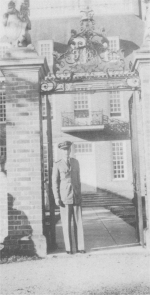
| 
| 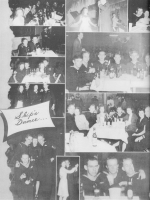
| 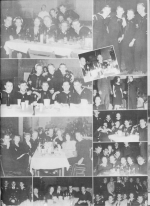
|
Up on the signal bridge the signal men of the ship kept visual communications going in all kinds of weather, and under all conditions. Like the rest of the divisions, the gang had been a green bunch at commissioning, but under the instruction of jack 'Red' Alden, approximately fifteen men advanced in rates during the years aboard. In addition to the constant blinking with escort vessels and with shore stations of ports throughout the world, the coffee and hot plates of the signal bridge furnished ample excuse for the exchange of sea stories-- for which the signal men became famous. One as the story of the famous message of the 'Mount Vernon' to the shore station at Gibraltar.
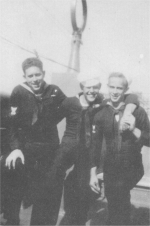
| 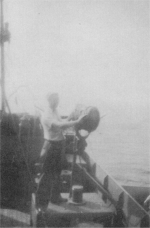
|
The ROCK OF GIBRALTAR, domineering and seemingly unapproachable had towered above the ship as she had passed though the Straits on previous occasions. How hard and how domineering would the Rock be to visitors?-- To Americans? Gibraltar welcomed the ship and her men as they had never expected to be greeted, warmly. They opened restricted and secret areas of the Rock for exploration. The galleries, the honeycomb of tunnels, the Morrish castle, the monkeys were shown in detail.
British troops billeted on the Rock displayed their good humor, too. Their Army personnel presented a variety show and concert for the 'M.V.'s' crew on the Arena. The ship's company arranged an evening's supper in return.
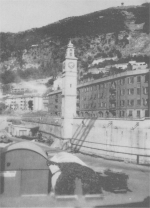
| 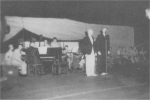
|
The River Clyde and the shipping industry combine to make GLASGOW, SCOTLAND the most important seaport of that country. Her proximity to Loch Lomond and Edinburgh made her more important in the eyes of the 'Mount Vernon's' globe traveling crew. Fortunate were those who traveled 'by yon bonnie banks . . . of Loch Lomond'. Liquid green of the hillsides flowed into the true blue of the water. The music of Bobby Burns' lyrics and the adventure of Sir Walter Scott and Robert Louis Stevenson rose from the land round about.
EDINBURGH was historical seat of the Kings of Scotland and traditional summer home of the Kings of England. High above the city broods the castle of Robert Bruce, scene of tragedy and triumph. Among the castle's famous prisoners was Mary, Queen of Scots, pretender to the crown of England. Although she died, later, in the Tower of London, her son James VI lived to reign as James I of England.
Each year, the reigning King of England walks the Royal mile from the castle to Holyrood Palace as a proof of his rule over Scotland. The street passes St. Jiles Church, scene of intrigues, and John Knox's house, birth place of the Presbyterian church."
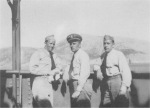
| 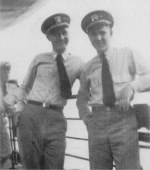
|
| Comments, Suggestions, E-mail Webmaster. |
|
This page is created and maintained by Gary P. Priolo |